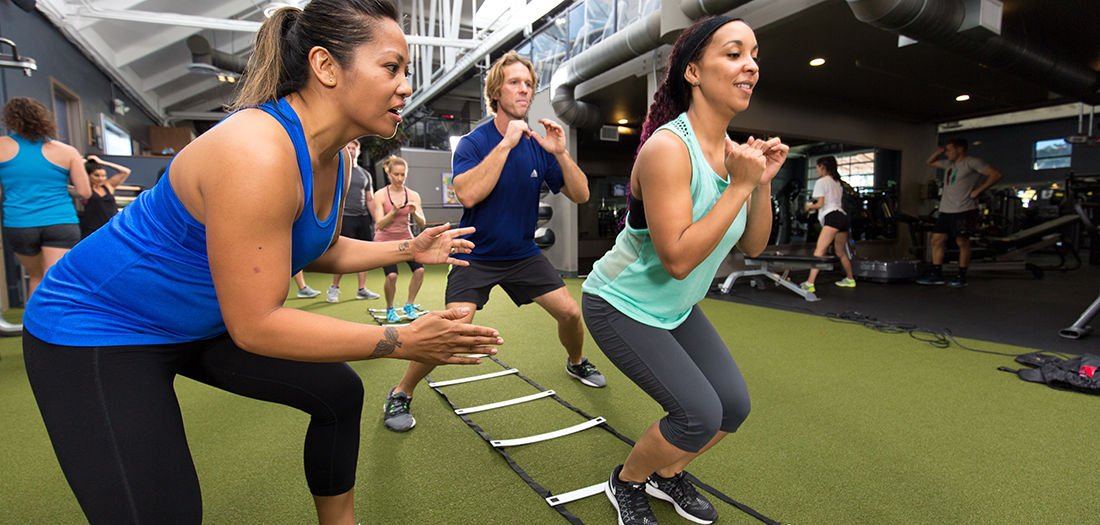Most personal trainers and group fitness instructors would agree that an average job “session” consists of three main parts: the start, the body and the finish. While we may spend most of our time planning the main portion (i.e., body) of the class, recent research shows that the greatest impact is felt by clients and participants during both the start (i.e., “intro”) and the finish (i.e., “outro”) of the class (Hall and Fishburne, 2010).
Intro: The Warm-up and Beyond

To set the stage for a compelling exercise experience, consider adding the following sections and topics into your warm-ups. Practice incorporating the topics into the introductory class remarks and while the participants get moving during the warm-up to keep a seamless flow of activity. Setting the following items not only helps engage more participants, but also sets you apart from the competition.
Set a First Teaser
A teaser is an element of fun introduced at the start of a session that will occur in its final third. The purpose of a teaser is to give participants a reason to stay for the entire experience with an anticipatory sense of excitement. Just as a server in a restaurant may profile a special dessert offered that day by saying, “Be sure to save room for the green tea cheesecake with a mixed sauce of organic berries,” giving clients something to look forward to introduces an unexpected surprise, taking them out of the “grind of fitness” that often occurs with regular attendees. To be sure, while this proves more difficult with a pre-choreographed approach, you can still find fun highlights from the last third of class to tease at the start, such as:
- Telling about a special song for the end of class
- Highlighting a new piece of equipment to be used in the final third of class
- Explaining a new layout configuration of participants or equipment (or both) that the class will adopt later in the class
- Teasing a game the students will plan near the end
- Showing a move that the students or clients will learn later in class, such as a new yoga animal, a variation of a burpee or a BOSU abdominal exercise
Teasers keep participants connected to the present session at hand with a fresh approach, helping to avoid the boredom and mindless compliance that they sometimes experience.
Set a Focus or Theme
Regardless of the class purpose, be it strength/endurance, cardiorespiratory, flexibility or balance, starting every session with a different focus brings everyone together in a new way. Even if the movements are pre-choreographed and remain unchanged for months, setting a different theme for each experience brings a fresh approach to the class and allows clients to connect on a different level each time. You can introduce the following sample themes at the outset by saying something like, “Today I invite you to focus on…”:
- Your breath as you exhale on the exertion phase of every movement
- Our balance as we incorporate physical balance in several different body positions
- The word “power,” because every song has to do with power in some way
- Closing your eyes on the last few repetitions of every set to see how that affects your kinesthetic awareness
- Posture and alignment in all of the body positions we’ll use today, sometimes using the mirror, and sometimes not
- The muscles in the ____ area, which we’re concentrating on today
Be sure to reiterate the focus or theme periodically during the session so that, when you ask them at the end what today’s focus was, everyone will be prepared to answer correctly. Just having a different focus for the same squat, for example, can bring a completely different feel to the movement, engaging students and clients, and keeping fitness feeling fresh.
Intensity
Ask participants to take responsibility for the intensity of their workouts by saying at the beginning of class: “Today, I’ll be showing three levels for most movements, and most of the time I will stay at level two. You have to choose the right level for you for each movement. I will ask you an hour from now if you chose the right intensity today at all times, for you.” This puts the responsibility of working at the appropriate intensity on each client, helping them realize that, as a certified professional, you are making movement suggestions, but the responsibility for the intensity comes internally from each client.
Verbal Hug
Many regular students like to hear their names used at least once per class. In a large group fitness setting, this proves challenging. One way to circumvent the challenge, but still let participants feel included in a personalized way, is to choose only three names. I call this a “verbal hug.” Choose one student’s name you know from the front left side of the room, one student’s name from the back of the room, and one name from the middle-to-front right side of the room. You can say something like, “I hope you’re ready to rock today,” or “Did you bring your A-game of energy today?” adding the verbal hug “from Mary on the left, to Alex in the back, to Susan on the right.” While you only have to know three names, incorporating participants from these specifically—and strategically chosen—places in the classroom, lets everyone feel included.
House Rules and Guidelines
When a class has a specific format protocol, such as Tabata, always explain it, however briefly, instead of assuming that everyone knows what is coming. For students leaving during class, consider saying something like, “If you have to leave for any reason, please give me a thumb’s-up sign so I know you’re O.K. and not leaving in physical distress.” If the club or facility has other announcements or rules, consider adding them at this section of class.
Everything Else
Consider recognizing new individuals so that they feel welcomed, but not threatened or singled-out. When appropriate, try explaining the equipment that will be used, the layout of the class, and anything special about the music, such as its theme, format, timing or volume. No participants can appreciate the time and effort we put into preparing class design and music unless we tell them exactly what we have prepared especially for them.
Outro: Making an Impression With Your Finish

The finishing sections of most personal training and group fitness experiences typically include flexibility exercises and activities to help participants transition from class to activities of daily life. During such times, incorporating the following topics will help close your compelling experience, while keeping participants moving.
Restate the Focus or Theme
Ask everyone, “What was our focus today, team?” Their answers will indicate how successful you were in setting a theme at the outset and weaving it throughout the session.
Set a Final Teaser
The first teaser in the intro gets everyone excited about a reason to stay, while the teaser given during the outro provides them with a reason to return. Assuming that even regular clients will keep returning could lead you to take their attendance for granted. Conversely, giving them something unique that they can look forward to can build anticipatory excitement and even help attract a larger number of participants to future sessions.
You can create teasers during the outro by mentioning:
- A unique piece of equipment you will add in your next class
- A new class configuration for participants, equipment or both
- A reason to come to check your Facebook wall, such as, “Tell me your favorite song and together we’ll build the playlist for next Monday’s class,” or “For next week’s class, we’ll only use one piece of equipment in our aqua class, so tell me your favorite equipment and we’ll see what the majority of participants decide.”
- The theme for the next session
Intensity
If during the intro you told participants that you would ask them at the end if they chose the appropriate intensity for themselves, remembering to do so completes the promise. Asking participants, “Did you choose the appropriate intensity today for you to reach your fitness goals?” reminds them of their complicit role in choosing appropriate for levels for all movements during each experience.
Gratitude
Thanking participants for coming lets them know how much you value their business. Furthermore, doing so with a verbal hug can help them feel both valued and appreciated. Plus, satisfied customers are 60 percent more likely to return (Biscontini, 2015).
Transcend the Classroom
Choosing just one element from class and assigning it as homework can help participants see your role as a bridge between fitness and life. For example, assigning the hip-hinge, deadlift position as a safe method for bending over when picking up items or performing bathroom tasks over the sink gives them a healthy alternative to the ubiquitous—and far less stable—unsupported forward spinal flexion. Saying, “Remember to use the hinges we did today at home as a way to bend over,” gives participants a role to take outside of the classroom and into their lives. Similarly, telling them at the end of flexibility or fitness yoga to “remember this deep diaphragmatic breathing the next time you feel stressed, such as when you’re stuck in traffic, can help your parasympathetic nervous system calm you down,” helps students see your role transcending the classroom confines into their daily lives. Ultimately, this underscores our roles as functional trainers, because such assignments not only show participants how truly functional our movements are, but also show them how much we care about their overall well-being.
References
Biscontini, L. (2015). Running the Show: Excellence in Service. New York: FG2000.
Hall, N. and Fishburne, G.J. (2010). Mental imagery research in physical education. Journal of Imagery Reseach in Sport and Physical Activity, 5, 1, 3.




 by
by 










 by
by